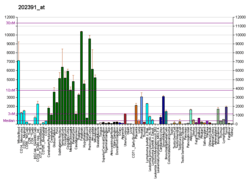BASP1
Brain acid soluble protein 1 is a protein that in humans is encoded by the BASP1 gene.[5][6][7]
This gene encodes a membrane bound protein with several transient phosphorylation sites and PEST motifs. Conservation of proteins with PEST sequences among different species supports their functional significance. PEST sequences typically occur in proteins with high turnover rates. Immunological characteristics of this protein are species specific. This protein also undergoes N-terminal myristoylation.[7]
References
- 1 2 3 GRCh38: Ensembl release 89: ENSG00000176788 - Ensembl, May 2017
- 1 2 3 GRCm38: Ensembl release 89: ENSMUSG00000045763 - Ensembl, May 2017
- ↑ "Human PubMed Reference:".
- ↑ "Mouse PubMed Reference:".
- ↑ Mosevitsky MI, Capony JP, Skladchikova GYu, Novitskaya VA, Plekhanov AYu, Zakharov VV (Nov 1997). "The BASP1 family of myristoylated proteins abundant in axonal termini. Primary structure analysis and physico-chemical properties". Biochimie. 79 (6): 373–84. doi:10.1016/S0300-9084(97)80032-6. PMID 9310187.
- ↑ Park S, Kim YI, Kim B, Seong C, Oh Y, Baek K, Yoon J (Nov 1998). "Characterization of bovine and human cDNAs encoding NAP-22 (22 kDa neuronal tissue-enriched acidic protein) homologs". Mol Cells. 8 (4): 471–7. PMID 9749536.
- 1 2 "Entrez Gene: BASP1 brain abundant, membrane attached signal protein 1".
External links
- Human BASP1 genome location and BASP1 gene details page in the UCSC Genome Browser.
Further reading
- Olsen JV, Blagoev B, Gnad F, et al. (2006). "Global, in vivo, and site-specific phosphorylation dynamics in signaling networks". Cell. 127 (3): 635–48. doi:10.1016/j.cell.2006.09.026. PMID 17081983.
- Gerhard DS, Wagner L, Feingold EA, et al. (2004). "The status, quality, and expansion of the NIH full-length cDNA project: the Mammalian Gene Collection (MGC)". Genome Res. 14 (10B): 2121–7. doi:10.1101/gr.2596504. PMC 528928. PMID 15489334.
- Carpenter B, Hill KJ, Charalambous M, et al. (2004). "BASP1 is a transcriptional cosuppressor for the Wilms' tumor suppressor protein WT1". Mol. Cell. Biol. 24 (2): 537–49. doi:10.1128/MCB.24.2.537-549.2004. PMC 343806. PMID 14701728.
- Strausberg RL, Feingold EA, Grouse LH, et al. (2003). "Generation and initial analysis of more than 15,000 full-length human and mouse cDNA sequences". Proc. Natl. Acad. Sci. U.S.A. 99 (26): 16899–903. doi:10.1073/pnas.242603899. PMC 139241. PMID 12477932.
- Fitzgibbon J, Neat MJ, Foot N, et al. (2000). "Assignment of brain acid-soluble protein 1 (BASP1) to human chromosome 5p15.1→p14, differential expression in human cancer cell lines as a result of alterations in gene dosage". Cytogenet. Cell Genet. 89 (3–4): 147–9. doi:10.1159/000015597. PMID 10965107.
This article is issued from
Wikipedia.
The text is licensed under Creative Commons - Attribution - Sharealike.
Additional terms may apply for the media files.




